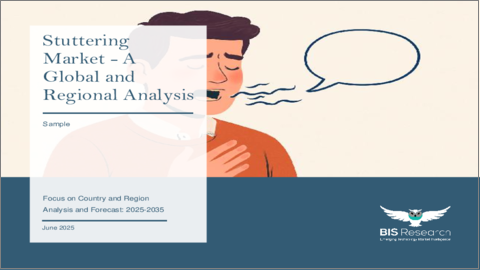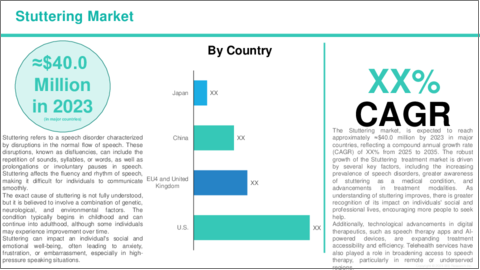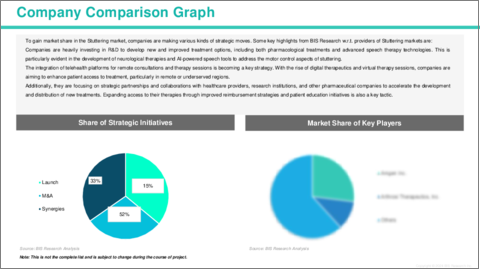|
|
市場調査レポート
商品コード
1764707
吃音症市場- 世界および地域別分析::国別、地域別 - 分析と予測(2025年~2035年)Stuttering Market - A Global and Regional Analysis: Focus on Country and Region - Analysis and Forecast, 2025-2035 |
||||||
カスタマイズ可能
|
|||||||
| 吃音症市場- 世界および地域別分析::国別、地域別 - 分析と予測(2025年~2035年) |
|
出版日: 2025年07月09日
発行: BIS Research
ページ情報: 英文 100 Pages
納期: 1~5営業日
|
全表示
- 概要
- 図表
- 目次
吃音の世界市場、分析と予測:2025年~2035年
吃音は、音声、音節、単語の繰り返しや、長時間の音や不随意な休止を伴う、音声の流れの頻繁な乱れを特徴とする言語障害です。
このような乱れは失行と呼ばれ、円滑な発話を困難にし、コミュニケーションに影響を及ぼします。吃音は通常、小児期に始まり、成人期まで持続することがありますが、吃音から脱却する人もいます。
吃音の原因は完全には解明されていませんが、遺伝的、神経学的、環境的要因が組み合わさって生じると考えられています。発語や運動制御をつかさどる脳領域の連携に問題がある場合もあります。吃音は知能とは関係ありませんが、精神的苦痛、社会的不安、個人的・職業的コミュニケーションの困難を引き起こすことがあります。
吃音の治療には、流暢さを改善し、話すことに関する不安を管理できるようにすることを目的とした言語療法、行動介入、場合によっては薬物療法が含まれることが多いです。ある種の抗うつ薬や抗精神病薬を含むいくつかの薬物治療は、吃音症状の軽減に役立つ可能性が検討されています。
吃音市場の主な促進要因のひとつは、治療可能な疾患としての吃音に対する認識と理解が高まっていることです。吃音の原因や影響に関する社会的知識が深まるにつれ、より多くの個人、特に子供が診断を受け、早期介入を受けるようになっています。このような意識の高まりは、偏見の減少につながり、個人が判断を恐れることなく治療を受けることを促しています。さらに、ヘルスケア提供者、教育者、保護者の間で認識が高まった結果、言語療法の早期紹介が行われるようになり、治療成績が大幅に向上しました。その結果、伝統的なものから革新的なものまで、また吃音に対処するための薬物療法に対する需要が増加しています。吃音が管理可能な障害であるという認識の高まりが、吃音治療市場の拡大を後押ししています。
吃音市場の成長にもかかわらず、いくつかの課題が依然としてその進展を妨げています。主な課題のひとつは、吃音に特化したFDA承認の薬がないことです。言語療法は依然として治療の要ですが、吃音の神経学的および運動制御的側面に直接対処できる薬理学的選択肢は限られています。このように的を絞った薬剤がないため、患者はしばしば適応外の薬剤に頼らざるを得ず、その薬剤は効果が低かったり、吃音に特化したものでなかったりします。さらに、吃音に対する効果的な薬剤の開発は、科学的および規制上のハードルに直面しており、製薬会社が新しい標的治療薬を市場に投入することを困難にしています。より優れた薬理学的介入の必要性は依然として吃音治療における重大なギャップであり、言語療法だけでは効果が上がらない患者に対する治療の選択肢を狭めています。
世界の吃音市場は競争が激しく、複数の主要企業が技術革新と市場成長を牽引しています。AstraZenecaは、Alexion Pharmaceuticalsの買収を通じて、吃音の重症型に対して承認された最初で唯一の酵素補充療法であるStrensiq(asfotase alfa)を提供する主要企業です。Mereo BioPharmaもまた、吃音症への関与は限定的ですが、希少疾患に焦点を当てた重要な参入企業です。骨の健康と代謝性疾患のリーダーであるAmgenは、現在吃音症に特化した治療法を提供していないにもかかわらず、吃音症領域にポートフォリオを拡大する可能性を秘めています。BridgeBio Pharmaは子会社のQED Therapeuticsを通じて遺伝子治療を進めており、その主な焦点は他の遺伝性疾患ですが、希少疾患に関する専門知識は将来吃音症の開発につながる可能性があります。これらの企業は、治療を進め、アンメットメディカルニーズに対応し、急成長する吃音症市場における患者の転帰を向上させる上で極めて重要です。
市場セグメンテーション:
セグメンテーション1:地域別
- 北米
- 欧州
- アジア太平洋
世界の吃音症市場は、治療の選択肢を再構築し患者アクセスを拡大する新たな動向に後押しされ、大きな変革期を迎えています。重要な動向のひとつは、AIを活用した音声療法アプリ、バーチャル診察、流暢性向上デバイスなどのデジタルヘルスツールの統合です。これらの技術革新により、特に十分な治療を受けていない地域でも治療がより身近になり、患者にはより柔軟で費用対効果の高いソリューションが提供されるようになっています。さらに、遺伝的要因や発話パターンを考慮するなど、個人の特定のニーズに合わせて治療を行う個別化医療への注目も高まっています。このアプローチは、吃音の根本原因に対処することで、より効果的な結果を約束するものです。
もうひとつの重要な動向は、吃音は治療可能な疾患であるという認識と受容が広まり、烙印を押されることが減り、より多くの人々、特に子供たちが早期診断と治療を受けるようになっていることです。その結果、吃音に特化した治療法や薬の需要が高まっています。また、遠隔治療や早期介入も勢いを増しています。これは、重要な言語開発の時期に即座に治療を行うことができ、長期的な成功の可能性が高まるからです。
最後に、吃音の神経学的・運動制御的側面を標的とした新薬の開発など、薬理学的治療の進歩が、現在の治療法とのギャップに対処する上で重要な役割を果たすと予想されます。このような新たな動向は総体的に吃音市場のダイナミックな成長を促し、吃音に罹患している人々により良い管理と生活の質の向上という新たな希望をもたらしています。
当レポートでは、世界の吃音症市場について調査し、市場の概要とともに、国・地域別の動向、および市場に参入する企業のプロファイルなどを提供しています。
目次
エグゼクティブサマリー
第1章 世界の吃音市場:業界展望
- イントロダクション
- 市場動向
- 規制の枠組み
- 疫学分析
- 臨床試験分析
- 市場力学
第2章 世界の吃音市場(地域別)、2023年~2035年
- 北米
- 欧州
- アジア太平洋
第3章 世界の吃音市場:競合情勢と企業プロファイル
- 主要戦略と開発
- 合併と買収
- 相乗効果のある活動
- 事業拡大と資金調達
- 製品の発売と承認
- その他の活動
- 企業プロファイル
- Emalex Biosciences Inc.
- Neurocrine Biosciences, Inc.
- Meda Pharmaceuticals (Part of Mylan/Viatoris)
- AbbVie Inc.
- Apax Partners (Invesco)
- Otsuka Pharmaceutical
第4章 調査手法
List of Figures
- Figure: Global Stuttering Market (by Region), $Billion, 2024 and 2035
- Figure: Global Stuttering Market Key Trends, Analysis
List of Tables
- Table: Global Stuttering Market Dynamics, Impact Analysis
- Table: Global Stuttering Market (by Region), $Billion, 2024-2035
Global Stuttering Market, Analysis and Forecast: 2025-2035
Stuttering is a speech disorder characterized by frequent disruptions in the flow of speech, which can involve repetitions of sounds, syllables, or words, as well as prolonged sounds or involuntary pauses. These disruptions, known as disfluencies, make it difficult for individuals to speak smoothly and can affect communication. Stuttering typically begins in childhood and may persist into adulthood, although some individuals may outgrow it.
The cause of stuttering is not entirely understood, but it is believed to result from a combination of genetic, neurological, and environmental factors. It may involve issues with the coordination between the brain regions responsible for speech production and motor control. While stuttering is not related to intelligence, it can cause emotional distress, social anxiety, and difficulty in personal and professional communication.
Treatment for stuttering often includes speech therapy, behavioural interventions, and, in some cases, medication, aimed at improving fluency and helping individuals manage anxiety related to speaking. Some pharmaceutical treatments, including certain antidepressants or antipsychotics, are being explored for their potential to help reduce stuttering symptoms.
One of the key drivers of the Stuttering market is the increasing awareness and understanding of stuttering as a treatable condition. As public knowledge grows regarding the causes and impact of stuttering, more individuals, particularly children, are being diagnosed and receiving early intervention. This heightened awareness has led to a reduction in stigma, encouraging individuals to seek treatment without fear of judgment. Additionally, increased awareness among healthcare providers, educators, and parents has resulted in earlier referrals for speech therapy, significantly improving outcomes. As a result, the demand for therapies, both traditional and innovative, as well as medications to address stuttering, is on the rise. This growing recognition of stuttering as a manageable disorder is propelling the expansion of the stuttering treatment market.
Despite the growth of the Stuttering market, several challenges continue to hinder its progress. One of the primary challenges is the lack of FDA-approved medications specifically for stuttering. While speech therapy remains the cornerstone of treatment, there is a limited range of pharmacological options available to directly address the neurological and motor control aspects of stuttering. This absence of targeted drugs means that patients often have to rely on off-label medications, which may not be as effective or specifically tailored for stuttering. Moreover, the development of effective drugs for stuttering faces scientific and regulatory hurdles, making it difficult for pharmaceutical companies to bring new, targeted treatments to market. The need for better pharmacological interventions remains a significant gap in the stuttering treatment landscape, limiting treatment options for individuals who do not respond well to speech therapy alone.
The global Stuttering market is highly competitive, with several leading companies driving innovation and market growth. AstraZeneca, through its acquisition of Alexion Pharmaceuticals, is a major player, offering Strensiq (asfotase alfa), the first and only enzyme replacement therapy approved for severe forms of STUTTERING. Mereo BioPharma is another key player, with its focus on rare diseases, although its involvement in Stuttering has been limited. Amgen, a leader in bone health and metabolic diseases, has the potential to expand its portfolio into the Stuttering space, despite not currently offering a specific treatment for the condition. BridgeBio Pharma, through its subsidiary QED Therapeutics, is advancing genetic therapies, and while its primary focus is on other genetic diseases, its expertise in rare disorders could lead to future developments for Stuttering. These companies are crucial in advancing treatments, addressing unmet medical needs, and enhancing patient outcomes in the rapidly growing Stuttering market.
Market Segmentation:
Segmentation 1: by Region
- North America
- Europe
- Asia-Pacific
The global Stuttering market is undergoing significant transformation, fueled by emerging trends that are reshaping treatment options and expanding patient access. One key trend is the integration of digital health tools, including AI-powered speech therapy apps, virtual consultations, and fluency-enhancing devices. These innovations are making treatment more accessible, particularly in underserved areas, and providing patients with more flexible, cost-effective solutions. Additionally, there is an increasing focus on personalized medicine, where treatments are tailored to the specific needs of individuals, including considering genetic factors and speech patterns. This approach promises more effective outcomes by addressing the root causes of stuttering.
Another important trend is the growing awareness and acceptance of stuttering as a treatable condition, reducing stigma and encouraging more people, especially children, to seek early diagnosis and treatment. This, in turn, is driving demand for therapies and medications specifically designed for stuttering. Teletherapy and early intervention are also gaining momentum, as they allow for more immediate treatment during the critical speech development years, improving the chances of long-term success.
Lastly, advances in pharmacological treatments, such as the development of novel drugs targeting the neurological and motor control aspects of stuttering, are expected to play a crucial role in addressing gaps in current therapy options. These emerging trends are collectively driving the dynamic growth of the stuttering market, bringing new hope for better management and improved quality of life for individuals affected by stuttering.
Table of Contents
Executive Summary
Scope and Definition
Market/Product Definition
Inclusion and Exclusion
Key Questions Answered
Analysis and Forecast Note
1. Global Stuttering Market: Industry Outlook
- 1.1 Introduction
- 1.2 Market Trends
- 1.3 Regulatory Framework
- 1.4 Epidemiology Analysis
- 1.5 Clinical Trial Analysis
- 1.6 Market Dynamics
- 1.6.1 Impact Analysis
- 1.6.2 Market Drivers
- 1.6.3 Market Challenges
- 1.6.4 Market Opportunities
2. Global Stuttering Market (by Region), ($Billion), 2023-2035
- 2.1 North America
- 2.1.1 Key Findings
- 2.1.2 Market Dynamics
- 2.1.3 Market Sizing and Forecast
- 2.1.3.1 North America Stuttering Market, by Country
- 2.1.3.1.1 U.S.
- 2.1.3.1 North America Stuttering Market, by Country
- 2.2 Europe
- 2.2.1 Key Findings
- 2.2.2 Market Dynamics
- 2.2.3 Market Sizing and Forecast
- 2.2.3.1 Europe Stuttering Market, by Country
- 2.2.3.1.1 Germany
- 2.2.3.1.2 U.K.
- 2.2.3.1.3 France
- 2.2.3.1.4 Italy
- 2.2.3.1 Europe Stuttering Market, by Country
- 2.3 Asia Pacific
- 2.3.1 Key Findings
- 2.3.2 Market Dynamics
- 2.3.3 Market Sizing and Forecast
- 2.3.3.1 Asia Pacific Stuttering Market, by Country
- 2.3.3.1.1 China
- 2.3.3.1.2 Japan
- 2.3.3.1 Asia Pacific Stuttering Market, by Country
3. Global Stuttering Market: Competitive Landscape and Company Profiles
- 3.1 Key Strategies and Development
- 3.1.1 Mergers and Acquisitions
- 3.1.2 Synergistic Activities
- 3.1.3 Business Expansions and Funding
- 3.1.4 Product Launches and Approvals
- 3.1.5 Other Activities
- 3.2 Company Profiles
- 3.2.1 Emalex Biosciences Inc.
- 3.2.1.1 Overview
- 3.2.1.2 Top Products / Product Portfolio
- 3.2.1.3 Top Competitors
- 3.2.1.4 Target Customers/End-Users
- 3.2.1.5 Key Personnel
- 3.2.1.6 Analyst View
- 3.2.2 Neurocrine Biosciences, Inc.
- 3.2.2.1 Overview
- 3.2.2.2 Top Products / Product Portfolio
- 3.2.2.3 Top Competitors
- 3.2.2.4 Target Customers/End-Users
- 3.2.2.5 Key Personnel
- 3.2.2.6 Analyst View
- 3.2.3 Meda Pharmaceuticals (Part of Mylan/Viatoris)
- 3.2.3.1 Overview
- 3.2.3.2 Top Products / Product Portfolio
- 3.2.3.3 Top Competitors
- 3.2.3.4 Target Customers/End-Users
- 3.2.3.5 Key Personnel
- 3.2.3.6 Analyst View
- 3.2.4 AbbVie Inc.
- 3.2.4.1 Overview
- 3.2.4.2 Top Products / Product Portfolio
- 3.2.4.3 Top Competitors
- 3.2.4.4 Target Customers/End-Users
- 3.2.4.5 Key Personnel
- 3.2.4.6 Analyst View
- 3.2.5 Apax Partners (Invesco)
- 3.2.5.1 Overview
- 3.2.5.2 Top Products / Product Portfolio
- 3.2.5.3 Top Competitors
- 3.2.5.4 Target Customers/End-Users
- 3.2.5.5 Key Personnel
- 3.2.5.6 Analyst View
- 3.2.6 Otsuka Pharmaceutical
- 3.2.6.1 Overview
- 3.2.6.2 Top Products / Product Portfolio
- 3.2.6.3 Top Competitors
- 3.2.6.4 Target Customers/End-Users
- 3.2.6.5 Key Personnel
- 3.2.6.6 Analyst View
- 3.2.1 Emalex Biosciences Inc.






